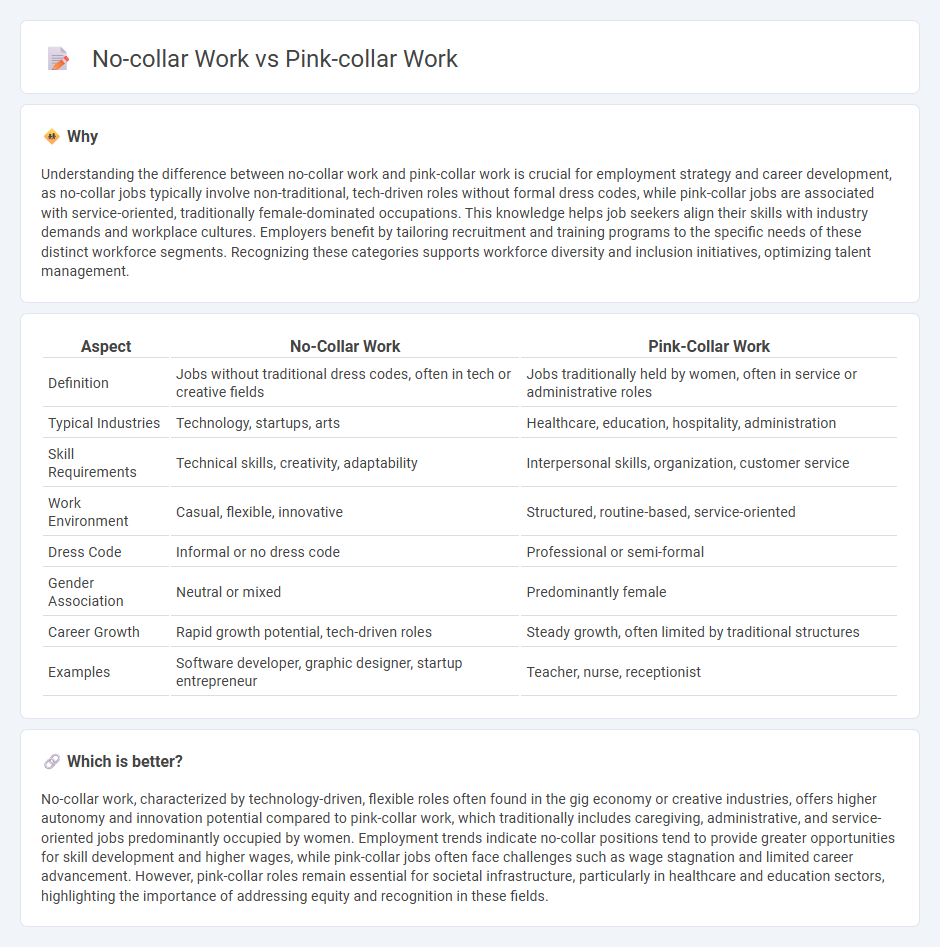
No-collar work refers to jobs in emerging industries such as technology and creative arts that prioritize skills over formal dress codes, often involving flexible, remote, or freelance arrangements. Pink-collar work encompasses roles traditionally held by women, including caregiving, administrative support, and education, highlighting ongoing gender-based occupational distinctions. Explore further to understand how these categories shape modern employment trends and workforce dynamics.
Why it is important
Understanding the difference between no-collar work and pink-collar work is crucial for employment strategy and career development, as no-collar jobs typically involve non-traditional, tech-driven roles without formal dress codes, while pink-collar jobs are associated with service-oriented, traditionally female-dominated occupations. This knowledge helps job seekers align their skills with industry demands and workplace cultures. Employers benefit by tailoring recruitment and training programs to the specific needs of these distinct workforce segments. Recognizing these categories supports workforce diversity and inclusion initiatives, optimizing talent management.
Comparison Table
| Aspect | No-Collar Work | Pink-Collar Work |
|---|---|---|
| Definition | Jobs without traditional dress codes, often in tech or creative fields | Jobs traditionally held by women, often in service or administrative roles |
| Typical Industries | Technology, startups, arts | Healthcare, education, hospitality, administration |
| Skill Requirements | Technical skills, creativity, adaptability | Interpersonal skills, organization, customer service |
| Work Environment | Casual, flexible, innovative | Structured, routine-based, service-oriented |
| Dress Code | Informal or no dress code | Professional or semi-formal |
| Gender Association | Neutral or mixed | Predominantly female |
| Career Growth | Rapid growth potential, tech-driven roles | Steady growth, often limited by traditional structures |
| Examples | Software developer, graphic designer, startup entrepreneur | Teacher, nurse, receptionist |
Which is better?
No-collar work, characterized by technology-driven, flexible roles often found in the gig economy or creative industries, offers higher autonomy and innovation potential compared to pink-collar work, which traditionally includes caregiving, administrative, and service-oriented jobs predominantly occupied by women. Employment trends indicate no-collar positions tend to provide greater opportunities for skill development and higher wages, while pink-collar jobs often face challenges such as wage stagnation and limited career advancement. However, pink-collar roles remain essential for societal infrastructure, particularly in healthcare and education sectors, highlighting the importance of addressing equity and recognition in these fields.
Connection
No-collar work, often associated with informal, creative, or gig economy roles, intersects with pink-collar work, which traditionally encompasses jobs in caregiving and service industries dominated by women. Both categories reflect evolving labor market dynamics influenced by technological innovation, gender roles, and socioeconomic shifts. The convergence highlights changing employment patterns where non-traditional, flexible job structures in no-collar work increasingly overlap with the service-oriented nature of pink-collar sectors.
Key Terms
Service sector
Pink-collar work primarily encompasses service sector roles involving caregiving, hospitality, and administrative support, often dominated by women and emphasizing interpersonal skills. No-collar work in the service industry typically refers to creative, tech-oriented, or non-traditional occupations that prioritize innovation and flexibility over conventional dress codes and hierarchical structures. Explore the evolving dynamics and job characteristics defining pink-collar and no-collar roles in the service sector for a deeper understanding.
Creative industry
Pink-collar work in the creative industry often involves roles such as design, fashion, and editorial positions traditionally occupied by women, emphasizing service and interpersonal skills. No-collar work refers to jobs in creative fields driven by innovation and technology, including artists, designers, and digital creators who operate independently without strict corporate hierarchies. Explore the evolving dynamics between these work categories and their impact on the creative sector.
Nontraditional roles
Pink-collar work traditionally refers to roles dominated by women, such as nursing, teaching, and administrative support, while no-collar work includes positions that emphasize creativity and flexibility, often found in technology and artistic fields. Nontraditional roles challenge these boundaries by encouraging men to enter pink-collar occupations and women to thrive in no-collar industries, promoting greater gender diversity and inclusion. Explore how embracing nontraditional roles reshapes career landscapes and opportunities.
Source and External Links
Pink Collar Jobs - TCWGlobal - Pink collar jobs are professions historically dominated by women, usually in service sectors like nursing, teaching, caregiving, and administrative support, emphasizing interpersonal skills and caregiving roles.
Pink-Collar Jobs: Past, Present, and Future - Datapeople - Pink-collar jobs are occupations predominantly held by women, often in caregiving, administrative, and service roles, traditionally linked to lower wages and limited career mobility but evolving with societal changes.
Pink-collar worker - Wikipedia - Pink-collar workers mainly hold care-oriented, service sector jobs such as nursing, teaching, and retail, mostly dominated by women and often underfunded or undervalued in economic planning and labor policies.
 dowidth.com
dowidth.com